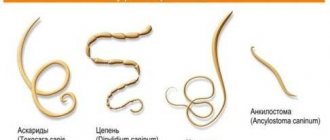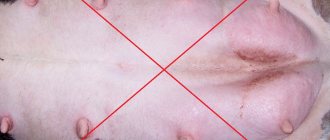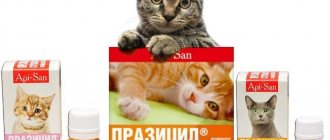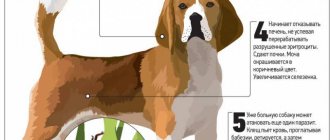Dogs show that they feel bad when it is no longer possible to endure and the pain syndrome must be relieved immediately. It’s good if the owner is prudent and has a first aid kit ready for all occasions.
But if not, what to do? How to quickly choose from the abundance of painkillers the one that will relieve pain and not harm your pet?
A review of 25 painkillers for dogs, which is based on my work practice and the experience of my colleagues, will help you understand this.
I have selected the most effective veterinary products and “human” drugs that are safe to give to animals at home.
In the article you will find descriptions of medications for all occasions (universal, potent, for injuries, joint diseases, after operations), and you will learn how to use them. At the end there are listed medications that should not be given.
Information about drugs and their costs is current as of January 2021 and is constantly updated.
Types of pain medications
Every owner is a bit of a veterinarian: he knows when and what medicines can be given to the dog. After all, feeding a dog with cancer analgesics is useless, and feeding strong painkillers for a bruise is inappropriate.
This guide to the types of painkillers will help you navigate and choose the right type of medication:
- Nutraceuticals. Medicines made from natural ingredients contain herbal extracts, acids, vitamins, and antioxidants. Used for diseases of the musculoskeletal system.
- Nonsteroidal anti-inflammatory drugs (NSAIDs). The largest group. Optimal according to the criteria result/price/side effects.
- Steroid drugs. They relieve painful symptoms and normalize physiological processes; they are indicated for inflammation. But they cause strong adverse reactions; medications are used rarely and under the supervision of a veterinarian.
- Opioid and narcotic medications. Prescribed for severe pain caused by cancer. The drugs have an analgesic and sedative effect, they cause euphoria and addiction.
Specialized veterinary drugs and medicines for people that can be used for animals are considered separately. In the second case, proceed with caution: most of the “human” products are dangerous for dogs. And the dosage of relatively safe ones differs from the prescriptions for humans.
Give your pet veterinary medications whenever possible. But in small towns they are difficult to find. And in emergency cases, it is faster to get to a regular pharmacy than to a veterinarian. Therefore, in the review I also indicated “human” medications that are suitable for pets.
Specialized products for dogs
There are not many specialized pain medications for dogs on the market. Veterinary pharmacies are limited to a list of four items. These are Novox, Rimadyl, Deracoxib, Meloxicam. All of them are non-steroidal drugs. Dog breeders note that such medications practically do not cause side effects when used correctly. However, in special cases they can cause digestive problems, diseases of the gastrointestinal tract, kidneys, peptic ulcers, and so on.
It is up to the veterinarian to decide what pain reliever can be given to the dog. The following names can be found in veterinary pharmacies for steroid drugs for four-legged animals: Amantadine, Gabapentin and Tramadol.
Painkillers
Pet owners often use tablets. They are easier to use than injections - no skills in administering injections are required. In addition, there is no risk of injecting the drug incorrectly if the animal breaks out.
The downside of the tablets is that they are bitter. Plus, pets are cunning, spit them out or swallow them not completely.
Analgin
Found in any first aid kit. Analgesic relieves pain and inflammation. But if the symptoms are severe, it will not work. Analgin is used when there is no other medicine at hand and you need to somehow reduce the painful syndrome.
Small breeds are given ½ tablet 1-3 times a day, large breeds - 1 tablet. 2-3 times a day. Dose – 1 capsule per 20 kg, course of treatment – 1-3 days.
Analgin has a bitter taste and provokes salivation. Therefore, the capsule is hidden in a treat.
Analgin costs 15-20 rubles.
Spazgan
Complex medicine. At the same time relieves pain, spasm, relaxes muscles. Plus it reduces inflammation. Spazgan is used for:
- diseases of the gastrointestinal tract;
- pathologies of the genitourinary system;
- colic;
- spastic conditions;
- joint pain;
- neurological disorders.
They give ½ tablet. Spazgana 3-4 times a day. Packaging costs 130 rubles.
No-shpa
A popular product based on drotaverine. Helps with spastic conditions, but is inferior to Spazgan in the analgesic and anti-inflammatory effect.
No-shpa is prescribed for:
- spasm of smooth muscles;
- diseases of the bladder and urinary tract;
- intestinal and gastric pathologies, constipation.
Give at the rate of 1 capsule per 10 kg. No-shpa costs 50 rubles.
Rimadyl R
Veterinary drug. Painkiller tablets are produced with liver flavor - dogs are happy to eat them themselves.
Rimadyl R is a non-steroidal anti-inflammatory drug. It relieves pain, inflammation, and lowers temperature. These effects are achieved due to the active substance carprofen - it blocks the synthesis of prostaglandins.
Rimadyl R is prescribed for joint diseases, injuries, and in the postoperative period. Dosage: 4 mg per 1 kg per day, divided into two doses. The course of treatment is 7 days, after which the drug is discontinued or reduced by half.
They sell Rimadyl R for 485 rubles.
Detailed article about Rimadyl for dogs.
Onsior
Another medication from the NSAID group. Good for syndromes caused by inflammation and infection. Helps with joint pathologies in the postoperative period.
Onsior for dogs is produced in 4 variations:
- for 2.5-5 kg – 1,000 rubles;
- for 5-12 kg – 1,500 rubles;
- from 20 kg – 2,500 rub.;
If the dog weighs from 40 kg to 80 kg, he is given 2-3 tablets of 20 mg.
Onsior is prohibited if you are dehydrated, exhausted, or weigh less than 2.5 kg. It is not prescribed to pregnant women or puppies under 3 months. The tablets are given whole, before or after feeding.
Ketofen
NSAIDs based on propionic acid. They are produced in 5, 10 or 20 mg of the active substance - ketoprofen. Ketofen costs from 600 to 1,000 rubles. depending on dosage.
Ketoprofen in the composition relieves pain caused by inflammation and infection. Suitable for the treatment of acute and chronic conditions: injuries, arthritis, arthrosis, hernias.
Ketofen is given at the rate of 1 mg of ketoprofen per 1 kg once a day with meals. Duration of treatment is 3-5 days. The medication is contraindicated for ulcers, renal failure, if the dog is given anticoagulants or diuretics.
Cymaljex
Cimalgex is given before and after surgery, for injuries, pathologies of the musculoskeletal system, to relieve inflammation, swelling, heat, and pain.
Available in 2 dosages - 8 mg of cimicoxib per tablet and 80 mg per capsule. It costs 400 rubles accordingly. and 1,200 rub.
Dosage: 2 mg of cimicoxib per 1 kg once a day. The course of treatment in the postoperative period is 3-7 days, for diseases of bones and joints - 3-6 months.
Cimalgex is a low-risk drug. But sometimes it causes digestive disorders and allergies: they go away on their own after stopping the medication. Prohibited:
- cubs up to 2.5 months;
- pets weighing less than 2 kg;
- pregnant dogs;
- dogs with blood, kidney, and liver diseases.
Carprodil F
Prescribed to relieve symptoms of chronic and acute diseases of the joints, ligaments, and skeleton. Also used after operations. Carprodil relieves swelling, lowers body temperature, and reduces tissue hyperemia.
Carprodil is given along with food at a dose of 2-4 mg per 1 kg daily in one or two doses. After a week, the dose is reduced twice.
Cost – 300 rub.
Previcox
Indicated for osteoarthritis, after operations on joints, soft tissues, and dental interventions. Previcox is based on firocoxib. Unlike other NSAIDs, the substance inhibits the synthesis of prostaglandins at the site of inflammation, without affecting the prostaglandins responsible for blood circulation in the kidneys and the integrity of the gastrointestinal mucosa.
Previcox is given at 5 mg per 1 kg. Tablets with smoked meat flavoring, so dogs eat them willingly.
Previcox costs 2,000 rubles. per package of 30 tablets. at a dosage of 57 mg.
Read a detailed review of Previcox for dogs.
Why do dogs need anti-inflammatory drugs?
Despite the fact that inflammation is a natural defense mechanism of the body fighting pathogenic elements, in some cases it is necessary to stop these processes, take control or eliminate them.
The body is usually able to cope with a small problem on its own. But protracted and extensive inflammatory processes no longer serve to protect the body, but turn against it. If large areas of tissue are inflamed for a long time, this can lead to their dysfunction and death. This also applies to organs.
Therefore, the prescription of anti-inflammatory drugs is one of the first measures for the treatment of many diseases and conditions in dogs. Often these are the consequences of injuries (bruises, sprains, dislocations, fractures), diseases of the musculoskeletal system, and postoperative conditions.
The main functions that anti-inflammatory drugs perform:
- reduction of redness and swelling;
temperature drop;
anesthesia.
However, not all anti-inflammatory drugs for dogs have the function of eliminating pain.
Injections
Injections are the best option for pain relief. They do not affect the gastrointestinal tract, and the effect is achieved in a short time. In addition, the owner is sure that all the medicine was injected during the injection - unlike tablets, solutions cannot be spat out.
The downside is that you need to know how to give injections. And sometimes animals struggle so much that it is impossible to administer the solution.
Ketonal
The best medicine for people that can be used by animals. Ketonal relieves severe pain, it has few side effects - sometimes vomiting and diarrhea are observed. In addition, it is inexpensive - 200-300 rubles.
Ketonal is administered at the rate of 1 mg per 1 kg, for puppies at 1-2 months - 0.1 mg per 1 kg. In case of painful shock, the dose of the first injection is doubled. Use the product for up to 10 days.
Ketonal is prohibited:
- cubs up to a month old;
- pregnant women – there is a high risk of miscarriage and intrauterine development disorders;
- in combination with corticosteroid drugs.
Ketanov
An analogue of Ketonal, produced by an Indian company. It is not inferior in effectiveness, but often leads to negative consequences. But it’s cheaper - they sell for 100-120 rubles.
Ketanov is administered intramuscularly for no more than 4 days in a row. Dosage – 0.4 ml per 10 kg. The drug is used in combination with analgin, diphenhydramine and ranitidine in the postoperative period.
Ainil
A specialized veterinary injection based on ketoprofen – 1 ml contains 10 mg of active ingredient. Ainil has an analgesic effect, reduces fever and relieves inflammation. Additionally prevents thrombus formation. Costs 1,600 rubles.
Ainil is administered intravenously, intramuscularly or subcutaneously at the rate of 0.2 ml per 1 kg. Duration of treatment – up to 3 days.
Ainil is not used in dogs with liver, kidney, or ulcer diseases. Observe the dosage - excess has a negative effect on the mucous membrane of the stomach and duodenum.
Flexoprofen
Another medicine for animals based on ketoprofen. It also effectively relieves pain in acute and chronic conditions. But it costs less than Ainil - from 500 rubles.
In addition to relieving pain symptoms, Flexoprofen is used for body overheating, fever, and febrile conditions.
Flexoprofen is administered subcutaneously, into a vein or muscle at the rate of 2 mg of ketoprofen per 1 kg once a day. Course – 1-5 days. Cannot be combined with diuretics, glucocorticoids, anticoagulants, and other NSAIDs.
Review of Flexoprofen
Baralgin
Cheap “human” medicine – sold for 200 rubles. It is used for dogs, but only once and in the dosage prescribed by the veterinarian. Otherwise, hematopoietic disorders may occur.
Baralgin is used when there are no veterinary analgesics, and the pain needs to be relieved urgently. Indications:
- injuries;
- pain shock;
- postoperative period;
- infections accompanied by fever and pain.
The maximum dosage is 1 cube of solution per 10 kg. It is advisable to administer less - 0.08 ml per kg.
Meloxicam
Another medicine for humans that is used as a replacement for veterinary drugs. It is prescribed for:
- fractures;
- dislocations and bruises;
- arthrosis and arthritis;
- after operations.
Meloxicam is prohibited for dogs with heart, kidney and liver failure. The drug rarely leads to side effects, mainly in case of overdose. Possible complications include gastrointestinal upset, apathy, and refusal to eat.
Meloxicam is administered intravenously (0.13 mg per kg on the first day, 0.7 mg per kg on subsequent days) or subcutaneously (0.2 mg per kg). Course duration – 3 days.
One ampoule of Meloxicam costs 50 rubles.
Fluniject
NSAIDs for animals. Prescribed for:
- temperature and overheating (hyperthermia);
- respiratory pathologies;
- inflammatory eye diseases;
- infectious processes;
- gynecological diseases.
Fluniject is administered intravenously or intramuscularly at the rate of 0.2 ml per 10 kg once a day. Course – 1-3 days.
They sell Fluniject for 740 rubles. per package.
Dexafort
Hormonal agent based on phenylpropionate and sodium phosphate. Mainly prescribed for autoimmune and allergic diseases. But it also helps with severe sensations that appear due to post-traumatic edema, arthritis, and arthrosis.
Dexafort is administered once, 0.5-1 ml. If necessary, give a second injection after a week.
Dexafort is not prescribed shortly before or immediately after vaccination. It is prohibited when:
- pregnancy;
- viral and fungal invasions;
- diabetes;
- renal and heart failure.
Cost – 900-1,000 rubles.
Read more about the drug Dexafort.
Steroid drugs for dogs
What painkillers can be given to a dog is determined by a veterinarian. Steroid medications are prescribed quite rarely, since they are often unnecessary or the side effects are so undesirable that the use of the drug is impossible. These include the following pain relievers for dogs:
- "Amantadine" - helps block pain. For dogs, it is prescribed as a treatment for arthritis, various spinal diseases and cancer. Diarrhea is often observed with its use.
- "Gabapentin." It is used for pain resulting from damaged nerve endings. Causes drowsiness in the first few days of use, then the dog gets used to this effect. It is usually prescribed as part of a combination of medications.
- Tramadol is a mild pain reliever. This drug is prescribed to older dogs that experience chronic illness due to age.
For oncology
It is logical to assume that for cancer, an opioid or narcotic pain reliever will be prescribed for the dog. But it's not that simple.
There are no such medications in veterinary pharmaceuticals. Therefore, medications are indicated for humans. But even for a person it is difficult to obtain them: each ampoule is accountable, the received, issued, and consumed vials are recorded.
You can get your pet out of drugs when you have:
- conclusion of the attending physician and veterinary commission;
- oncologist's permission;
- recipe.
But opioids are usually impossible to obtain. Therefore, dogs with oncology are injected with potent drugs from other groups: Ketonal, Ketanov, Ketarol, Travmadol, Promedol. However, they are also prescribed by prescription.
Kinds
A veterinarian should prescribe pain medication for your cat. Only a specialist can assess the need for analgesic therapy and select the type, brand and dosage of the medication. When prescribing, the biometric characteristics of the pet (weight, age, gender), its health and physiological condition must be taken into account.
In cat veterinary medicine, a limited list of drugs is used.
Most analgesics used to treat humans, dogs, and large pets are toxic to cats.
Types of drugs used in cats:
- Opioids. Narcotic drugs.
- Non-steroidal anti-inflammatory drugs.
- Local anesthetics.
- Alpha2-adrenergic agonists (alpha2-adrenergic receptor agonists).
- NMDA receptor antagonists.
- Anticonvulsants.
For joint pain
Any painkiller will help relieve joint pain. But pharmacists produce special medications for the musculoskeletal system. In addition to analgesic substances, the products contain components that stimulate the restoration of joints and ligaments.
Quadrisol
The best remedy for relieving symptoms of arthrosis, dysplasia, arthritis. Quadrisol is packaged in dispenser syringes - one of 15 ml costs 300-400 rubles.
Quadrisol is given forcibly or mixed with wet food. Dosage – 1 ml per 10 kg every day. The course of treatment is 2-4 weeks, after a 7-day break the therapy is repeated as prescribed by the veterinarian.
Norocarp
A nonsteroidal anti-inflammatory drug prescribed for acute and chronic inflammation of joints, ligaments, fractures, and intervertebral hernias.
Norocarp is produced in tablets. The daily norm is 4 mg per 1 kg, divided into 2 doses. The medicine is given for a week; if the dog’s condition improves, the dose is reduced by half. The duration of the course of treatment is determined by the veterinarian.
Norocarp costs 230-500 rubles. depending on the release form - 20, 50 or 100 mg.
Hondartron-gel
Homeopathic medicine for external use. Contains a squeeze of medicinal herbs, bee venom, calcium fluoride and lithium carbonate. Hondatron:
- relieves inflammation, swelling;
- reduces pain symptoms;
- normalizes lymphatic drainage, blood flow and trophism (nutrition) of joints;
- stimulates the restoration of cartilage and joint tissues.
Chondartron is used in combination with other drugs to restore joints. The gel is applied evenly to the affected areas, avoiding damage.
They sell Hondatron-gel for 360 rubles. for a 75 ml bottle, and 1,200 rubles. per 500 ml tube.
Meloxidil
An NSAID that contains the substance meloxicam (analgesic) and additional components for joint restoration - gum, silicon, xylitol, sorbitol.
Meloxidil is produced in two variations of dispensing syringes - for small and large breeds. One division of the small dispenser is designed for 0.5 kg, and the large one is designed for 2.5 kg. Relief occurs on the 3-4th day, the full course is 10 days.
They sell Meloxidil for 850 – 1,300 rubles. depending on the volume of the bottle.
Pentalgin-gel
One of the most popular analgesics that dogs can use. Usually given in tablets (1/2 capsule per 20 kg). But the medicine is also available in gel form. If you don't have it at hand
veterinary ointments for joint pain, use Pentalgin - this is an excellent temporary measure.
Pentalgin-gel contains ketoprofen and auxiliary components: peppermint and pepper extracts, dimexide, camphor. It penetrates the source of inflammation and relieves unpleasant symptoms.
The gel costs 200 rubles.
Symptoms of Arthritis in Dogs
The most important sign of a dog’s illness is a decrease in its physical activity.
Over time, other signs appear:
- the dog is not able to cover long distances, he lies or sleeps more and more;
- while walking, the animal tries not to step on one of its hind legs;
- if two joints are damaged at once, the dog rarely gets up, but if it does move, it does so very slowly and with extreme caution;
- when touching the source of inflammation, the dog may become aggressive or irritable;
- the animal walks awkwardly, limps, rarely bends its hind limbs;
- runs very slowly or does not do so at all, refuses to jump or even climb stairs;
- often the dog refuses to eat;
- the animal gains excess weight due to lack of sufficient physical activity;
- the dog does not feel well when the weather changes (this is especially true in rainy or windy weather);
- the pet is increasingly lying on only one “healthy” side;
- joints increase in size.
Read Method of use and cost of Advantage for dogs
If even one of the described symptoms appears, contact a specialist for timely diagnosis of the disease and initiation of therapy.
For injuries
Pain from fractures, dislocations, bruises, and cuts is eliminated immediately. If the injuries are serious, they will lead to painful shock. Therefore, they act immediately. In addition to tablets and injections, external agents are used - they work directly at the site of injury.
Lidocaine spray
Dogs often injure their paws while walking, cutting themselves, or bruising them. Therefore, lidocaine in spray form should always be in the first aid kit.
Lidocaine “freezes” the damaged area. It is good for punctures, lacerations and cuts, bruises, dislocations. Spray with 2-3 pumps.
Lidocaine spray costs 250 rubles.
Travmatin
Analgesic based on herbal extracts. The main advantage is that it removes exudate, improves blood microcirculation and regeneration.
Travmatin is prescribed in combination with other analgesics. Used for acute injuries, after childbirth and operations.
A 10 ml bottle sells from 280 rubles.
Full review and instructions for using traumatine.
Trauma gel
Another herbal medicine. In addition to herbal extracts, it contains alcohol, glycerin and ammonia.
Trauma gel is applied for accidental injuries and injuries that occur after surgery. They lubricate their paws before and after walks to protect the skin from road reagents.
A bottle of minimum volume (20 ml) costs 190 rubles.











